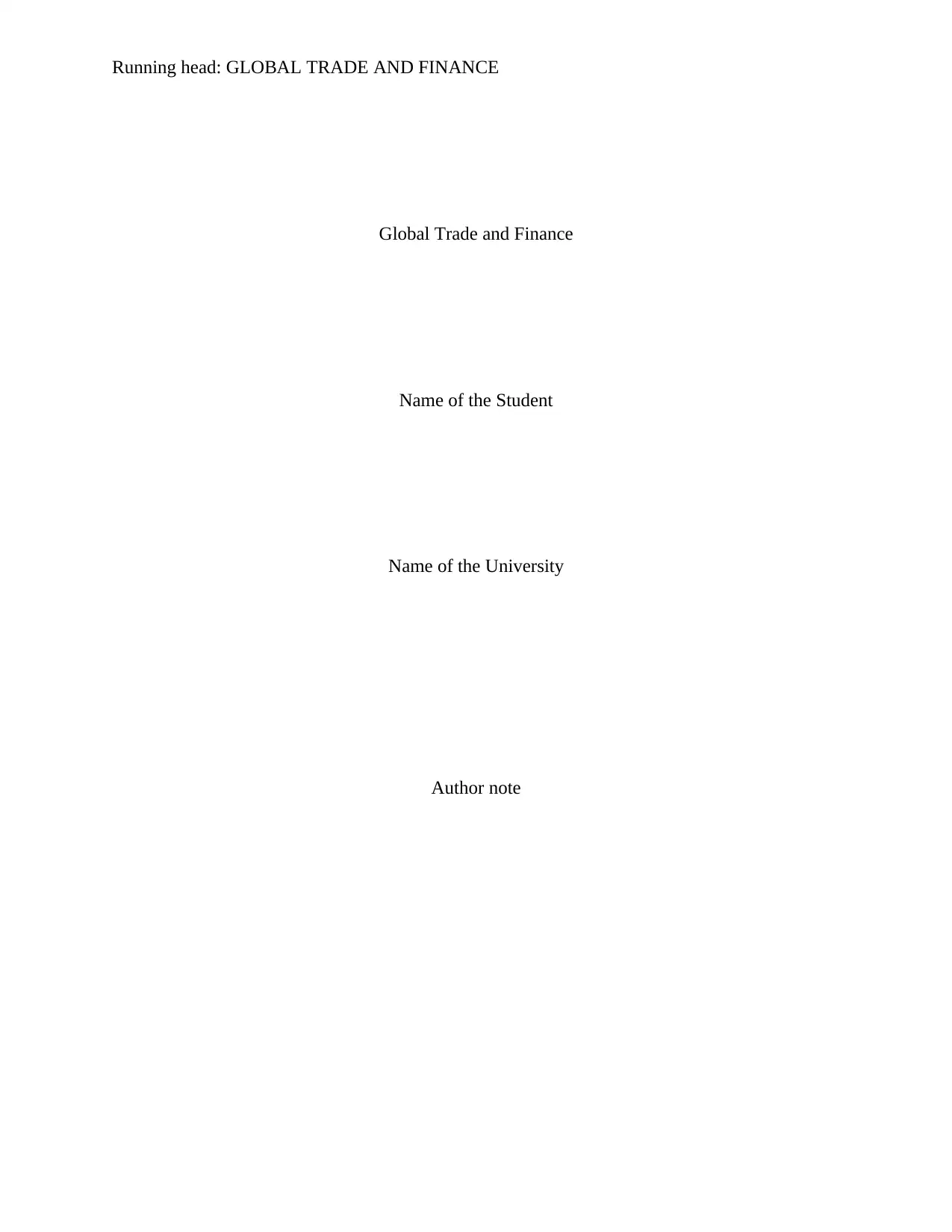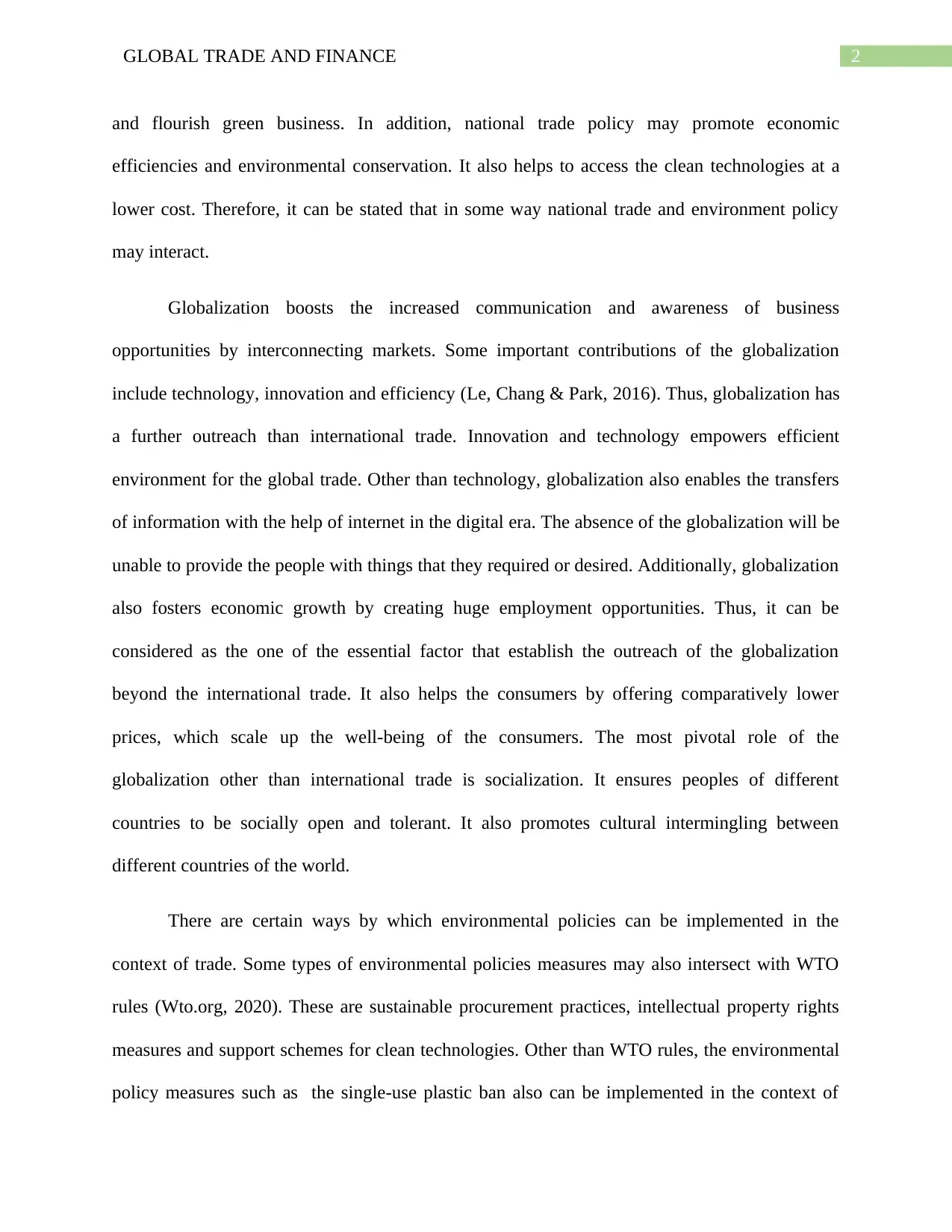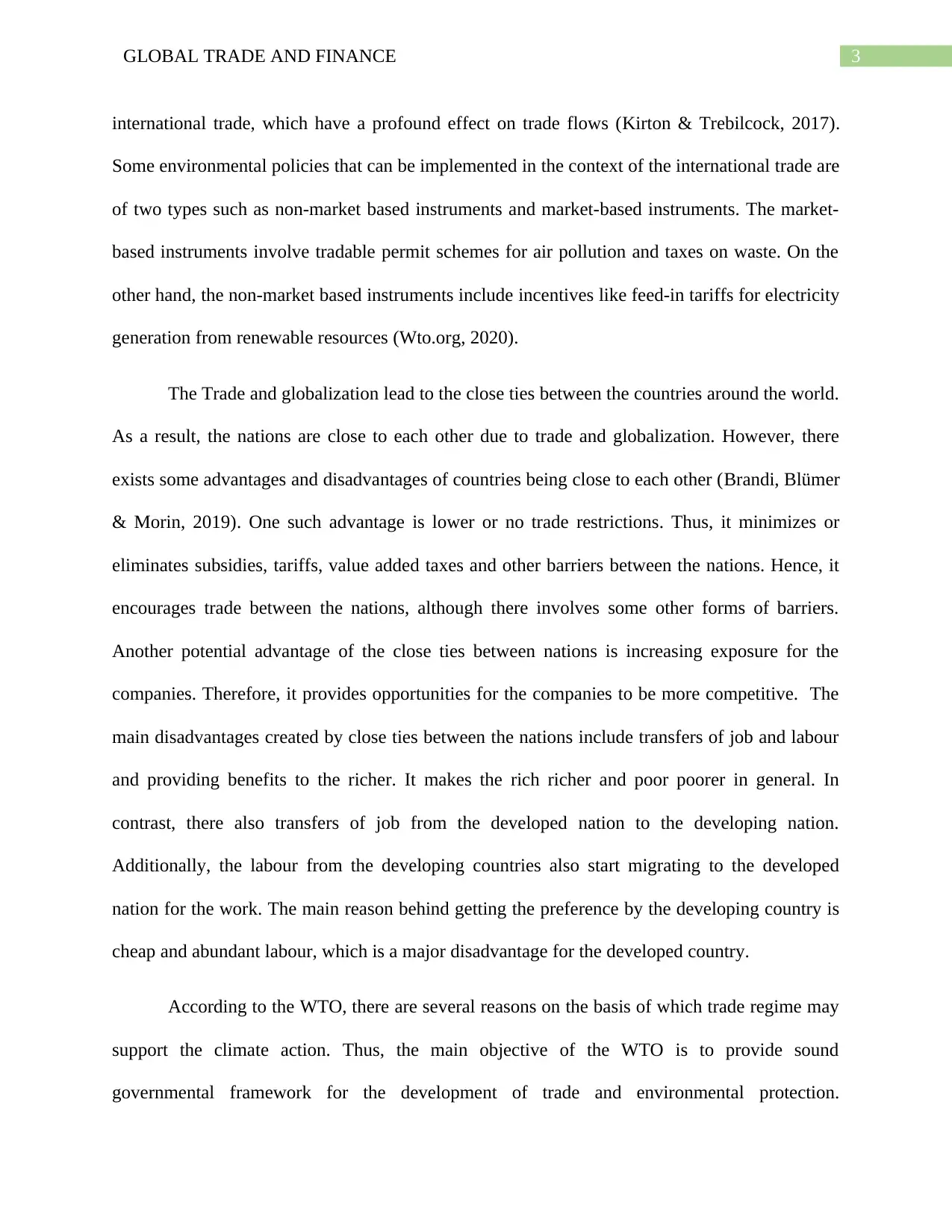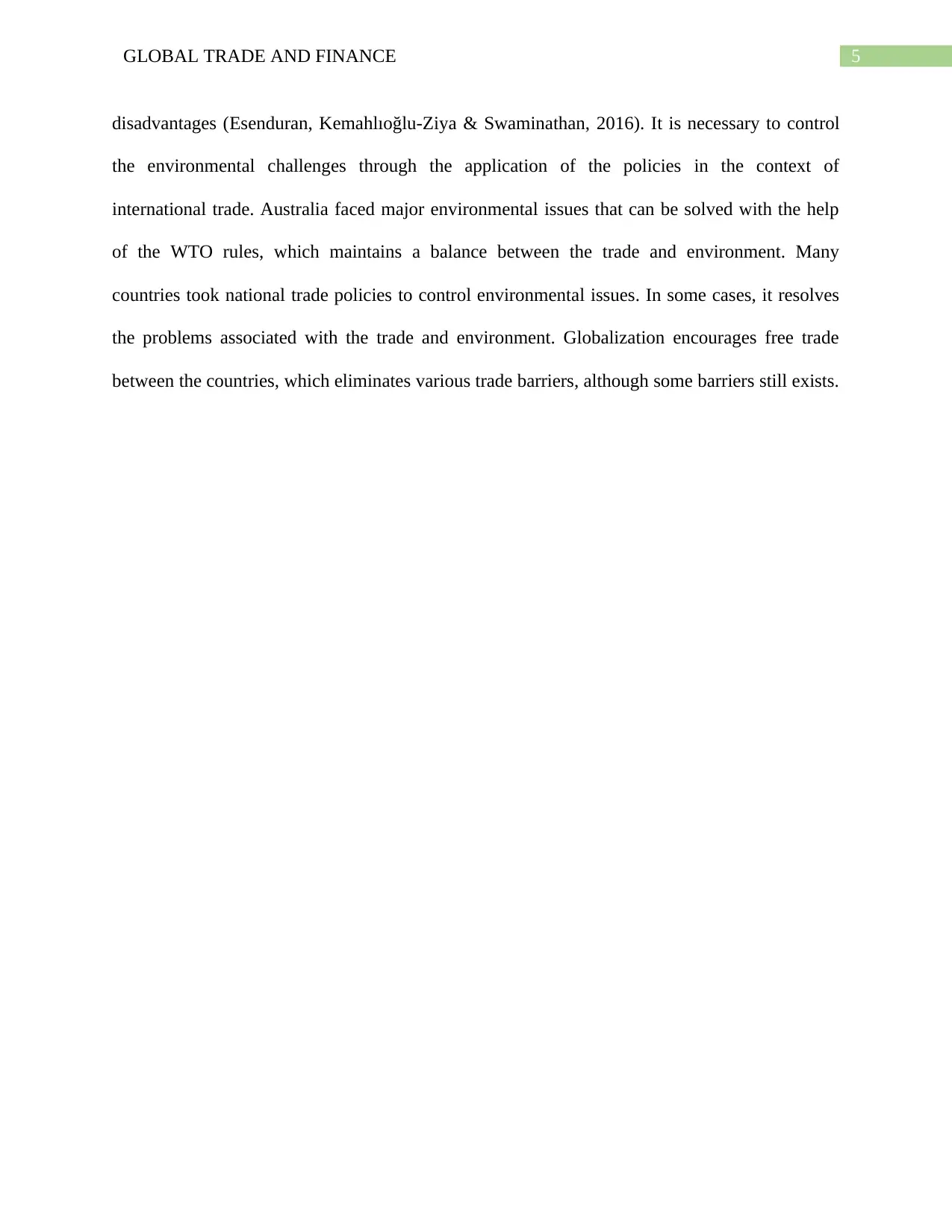Global Trade and Finance Essay: Trade, Environment, and Development
VerifiedAdded on 2022/09/12
|8
|1711
|29
Essay
AI Summary
This essay examines the intricate relationship between international trade and the environment, focusing on the implications for global sustainable development. It explores how globalization and trade impact environmental issues, such as greenhouse gas emissions, and discusses the role of national trade policies in addressing these challenges. The essay references Australia's specific context, highlighting the country's environmental problems and trade policies, including free trade agreements and the WTO rules. It also analyzes the advantages and disadvantages of globalization, the implementation of environmental policies within the context of trade, and the contributions of the WTO in promoting both trade and environmental protection. The author emphasizes the need for strategic policies and regulations to mitigate the adverse effects of trade on the environment, advocating for a balance between economic growth and environmental sustainability.

Running head: GLOBAL TRADE AND FINANCE
Global Trade and Finance
Name of the Student
Name of the University
Author note
Global Trade and Finance
Name of the Student
Name of the University
Author note
Paraphrase This Document
Need a fresh take? Get an instant paraphrase of this document with our AI Paraphraser

1GLOBAL TRADE AND FINANCE
Introduction
The interconnected between the countries around increased due to the globalization. The
trade related to goods and services brings some environmental and social consequences.
Therefore, the relationship between the trade and environmental policy is vital. The impact of the
globalization spread beyond the international trade. As the connectivity between the countries
shoot up because of the globalization, it generates some advantages as well as disadvantages for
the countries. One of the major economies of the world Australia faced some challenges while
maintaining the global environmental and trade problems (Abc.net.au, 2019). The main
environmental problems arises from the emissions of greenhouse gases like CO2, which affects
the climate worldwide. However, the trade results in growth of the GDP per capita and makes the
country richer. Though, it is bad from environmental perspective, it also provides the country
adequate capital to protect the environment in the long run.
Body
The trade and environment is interconnected and national trade policy plays an important
role in this regard. Moreover, the domestic environmental laws also promotes the effective
enforcement of the trade-related environmental challenges such as controlling emission of
greenhouse gas emissions and protecting the ozone layers. In this context, to promote the
international trade without disturbing the environmental balances, the government of Australia is
negotiated free trade agreements and Trans Pacific Partnership agreement. It will scale up the
environmental standards of participating countries along with trade and economic integration. On
the contrary, there are some limitations in controlling the environmental issues alone with the
national policies. Moreover, in some cases, it able to establish a connection to control
environmental issues with the help of national trade policy. National trade policies may expand
Introduction
The interconnected between the countries around increased due to the globalization. The
trade related to goods and services brings some environmental and social consequences.
Therefore, the relationship between the trade and environmental policy is vital. The impact of the
globalization spread beyond the international trade. As the connectivity between the countries
shoot up because of the globalization, it generates some advantages as well as disadvantages for
the countries. One of the major economies of the world Australia faced some challenges while
maintaining the global environmental and trade problems (Abc.net.au, 2019). The main
environmental problems arises from the emissions of greenhouse gases like CO2, which affects
the climate worldwide. However, the trade results in growth of the GDP per capita and makes the
country richer. Though, it is bad from environmental perspective, it also provides the country
adequate capital to protect the environment in the long run.
Body
The trade and environment is interconnected and national trade policy plays an important
role in this regard. Moreover, the domestic environmental laws also promotes the effective
enforcement of the trade-related environmental challenges such as controlling emission of
greenhouse gas emissions and protecting the ozone layers. In this context, to promote the
international trade without disturbing the environmental balances, the government of Australia is
negotiated free trade agreements and Trans Pacific Partnership agreement. It will scale up the
environmental standards of participating countries along with trade and economic integration. On
the contrary, there are some limitations in controlling the environmental issues alone with the
national policies. Moreover, in some cases, it able to establish a connection to control
environmental issues with the help of national trade policy. National trade policies may expand

2GLOBAL TRADE AND FINANCE
and flourish green business. In addition, national trade policy may promote economic
efficiencies and environmental conservation. It also helps to access the clean technologies at a
lower cost. Therefore, it can be stated that in some way national trade and environment policy
may interact.
Globalization boosts the increased communication and awareness of business
opportunities by interconnecting markets. Some important contributions of the globalization
include technology, innovation and efficiency (Le, Chang & Park, 2016). Thus, globalization has
a further outreach than international trade. Innovation and technology empowers efficient
environment for the global trade. Other than technology, globalization also enables the transfers
of information with the help of internet in the digital era. The absence of the globalization will be
unable to provide the people with things that they required or desired. Additionally, globalization
also fosters economic growth by creating huge employment opportunities. Thus, it can be
considered as the one of the essential factor that establish the outreach of the globalization
beyond the international trade. It also helps the consumers by offering comparatively lower
prices, which scale up the well-being of the consumers. The most pivotal role of the
globalization other than international trade is socialization. It ensures peoples of different
countries to be socially open and tolerant. It also promotes cultural intermingling between
different countries of the world.
There are certain ways by which environmental policies can be implemented in the
context of trade. Some types of environmental policies measures may also intersect with WTO
rules (Wto.org, 2020). These are sustainable procurement practices, intellectual property rights
measures and support schemes for clean technologies. Other than WTO rules, the environmental
policy measures such as the single-use plastic ban also can be implemented in the context of
and flourish green business. In addition, national trade policy may promote economic
efficiencies and environmental conservation. It also helps to access the clean technologies at a
lower cost. Therefore, it can be stated that in some way national trade and environment policy
may interact.
Globalization boosts the increased communication and awareness of business
opportunities by interconnecting markets. Some important contributions of the globalization
include technology, innovation and efficiency (Le, Chang & Park, 2016). Thus, globalization has
a further outreach than international trade. Innovation and technology empowers efficient
environment for the global trade. Other than technology, globalization also enables the transfers
of information with the help of internet in the digital era. The absence of the globalization will be
unable to provide the people with things that they required or desired. Additionally, globalization
also fosters economic growth by creating huge employment opportunities. Thus, it can be
considered as the one of the essential factor that establish the outreach of the globalization
beyond the international trade. It also helps the consumers by offering comparatively lower
prices, which scale up the well-being of the consumers. The most pivotal role of the
globalization other than international trade is socialization. It ensures peoples of different
countries to be socially open and tolerant. It also promotes cultural intermingling between
different countries of the world.
There are certain ways by which environmental policies can be implemented in the
context of trade. Some types of environmental policies measures may also intersect with WTO
rules (Wto.org, 2020). These are sustainable procurement practices, intellectual property rights
measures and support schemes for clean technologies. Other than WTO rules, the environmental
policy measures such as the single-use plastic ban also can be implemented in the context of
⊘ This is a preview!⊘
Do you want full access?
Subscribe today to unlock all pages.

Trusted by 1+ million students worldwide

3GLOBAL TRADE AND FINANCE
international trade, which have a profound effect on trade flows (Kirton & Trebilcock, 2017).
Some environmental policies that can be implemented in the context of the international trade are
of two types such as non-market based instruments and market-based instruments. The market-
based instruments involve tradable permit schemes for air pollution and taxes on waste. On the
other hand, the non-market based instruments include incentives like feed-in tariffs for electricity
generation from renewable resources (Wto.org, 2020).
The Trade and globalization lead to the close ties between the countries around the world.
As a result, the nations are close to each other due to trade and globalization. However, there
exists some advantages and disadvantages of countries being close to each other (Brandi, Blümer
& Morin, 2019). One such advantage is lower or no trade restrictions. Thus, it minimizes or
eliminates subsidies, tariffs, value added taxes and other barriers between the nations. Hence, it
encourages trade between the nations, although there involves some other forms of barriers.
Another potential advantage of the close ties between nations is increasing exposure for the
companies. Therefore, it provides opportunities for the companies to be more competitive. The
main disadvantages created by close ties between the nations include transfers of job and labour
and providing benefits to the richer. It makes the rich richer and poor poorer in general. In
contrast, there also transfers of job from the developed nation to the developing nation.
Additionally, the labour from the developing countries also start migrating to the developed
nation for the work. The main reason behind getting the preference by the developing country is
cheap and abundant labour, which is a major disadvantage for the developed country.
According to the WTO, there are several reasons on the basis of which trade regime may
support the climate action. Thus, the main objective of the WTO is to provide sound
governmental framework for the development of trade and environmental protection.
international trade, which have a profound effect on trade flows (Kirton & Trebilcock, 2017).
Some environmental policies that can be implemented in the context of the international trade are
of two types such as non-market based instruments and market-based instruments. The market-
based instruments involve tradable permit schemes for air pollution and taxes on waste. On the
other hand, the non-market based instruments include incentives like feed-in tariffs for electricity
generation from renewable resources (Wto.org, 2020).
The Trade and globalization lead to the close ties between the countries around the world.
As a result, the nations are close to each other due to trade and globalization. However, there
exists some advantages and disadvantages of countries being close to each other (Brandi, Blümer
& Morin, 2019). One such advantage is lower or no trade restrictions. Thus, it minimizes or
eliminates subsidies, tariffs, value added taxes and other barriers between the nations. Hence, it
encourages trade between the nations, although there involves some other forms of barriers.
Another potential advantage of the close ties between nations is increasing exposure for the
companies. Therefore, it provides opportunities for the companies to be more competitive. The
main disadvantages created by close ties between the nations include transfers of job and labour
and providing benefits to the richer. It makes the rich richer and poor poorer in general. In
contrast, there also transfers of job from the developed nation to the developing nation.
Additionally, the labour from the developing countries also start migrating to the developed
nation for the work. The main reason behind getting the preference by the developing country is
cheap and abundant labour, which is a major disadvantage for the developed country.
According to the WTO, there are several reasons on the basis of which trade regime may
support the climate action. Thus, the main objective of the WTO is to provide sound
governmental framework for the development of trade and environmental protection.
Paraphrase This Document
Need a fresh take? Get an instant paraphrase of this document with our AI Paraphraser

4GLOBAL TRADE AND FINANCE
Furthermore, WTO also supports the idea of reduction in trade barriers and elimination of
discriminatory treatment in international trade relations (Panayotou, 2016). However, there is no
specific agreement under the WTO to deal the environment. Hence, the countries may adopt the
trade-related measures to maintain the relationship between the environment and trade
legislation. The WTO contributes in trade openness through preservation and protection of the
environment (Wto.org, 2020). The ongoing efforts of the WTO under the Doha Agenda involves
some specific negotiations on environment and trade. Additionally, under this agenda some tasks
also assigned to the regular environment and trade committee. Therefore, as per the WTO the
interaction between the environment and trade legislation is essential to create a balance between
these two.
The economy of Australia suffered from the severe environmental issues due to
increasing trade and other economic activities. The level of consumption and production in the
Australia is higher, it resulted in environmental disruption (McGovern, 2018). Thus, in order to
prevent further deterioration in environment, the government should adopt some trade policies
that will abide by the environmental policies. In addition, the country may also participate in
international trade by implementing the WTO rules, which will promote trade along with
environmental protection. Hence, it is recommended for the Australia to implement appropriate
strategic policies and regulations to negate the adverse effect of the environmental challenges
faced by the country because of the trade.
Conclusion
There is a significant relationship between the trade and environment. Trade with the help
of globalization bring economic growth as well as environmental challenges. Thus, the
interconnectedness between the nations due to the trade and globalization creates advantages and
Furthermore, WTO also supports the idea of reduction in trade barriers and elimination of
discriminatory treatment in international trade relations (Panayotou, 2016). However, there is no
specific agreement under the WTO to deal the environment. Hence, the countries may adopt the
trade-related measures to maintain the relationship between the environment and trade
legislation. The WTO contributes in trade openness through preservation and protection of the
environment (Wto.org, 2020). The ongoing efforts of the WTO under the Doha Agenda involves
some specific negotiations on environment and trade. Additionally, under this agenda some tasks
also assigned to the regular environment and trade committee. Therefore, as per the WTO the
interaction between the environment and trade legislation is essential to create a balance between
these two.
The economy of Australia suffered from the severe environmental issues due to
increasing trade and other economic activities. The level of consumption and production in the
Australia is higher, it resulted in environmental disruption (McGovern, 2018). Thus, in order to
prevent further deterioration in environment, the government should adopt some trade policies
that will abide by the environmental policies. In addition, the country may also participate in
international trade by implementing the WTO rules, which will promote trade along with
environmental protection. Hence, it is recommended for the Australia to implement appropriate
strategic policies and regulations to negate the adverse effect of the environmental challenges
faced by the country because of the trade.
Conclusion
There is a significant relationship between the trade and environment. Trade with the help
of globalization bring economic growth as well as environmental challenges. Thus, the
interconnectedness between the nations due to the trade and globalization creates advantages and

5GLOBAL TRADE AND FINANCE
disadvantages (Esenduran, Kemahlıoğlu‐Ziya & Swaminathan, 2016). It is necessary to control
the environmental challenges through the application of the policies in the context of
international trade. Australia faced major environmental issues that can be solved with the help
of the WTO rules, which maintains a balance between the trade and environment. Many
countries took national trade policies to control environmental issues. In some cases, it resolves
the problems associated with the trade and environment. Globalization encourages free trade
between the countries, which eliminates various trade barriers, although some barriers still exists.
disadvantages (Esenduran, Kemahlıoğlu‐Ziya & Swaminathan, 2016). It is necessary to control
the environmental challenges through the application of the policies in the context of
international trade. Australia faced major environmental issues that can be solved with the help
of the WTO rules, which maintains a balance between the trade and environment. Many
countries took national trade policies to control environmental issues. In some cases, it resolves
the problems associated with the trade and environment. Globalization encourages free trade
between the countries, which eliminates various trade barriers, although some barriers still exists.
⊘ This is a preview!⊘
Do you want full access?
Subscribe today to unlock all pages.

Trusted by 1+ million students worldwide

6GLOBAL TRADE AND FINANCE
References
Abc.net.au (2019). 'Take your s*** from Indonesia': Australia accused of smuggling waste to
East Java. ABC News. https://www.abc.net.au/news/2019-04-30/australia-accused-of-
smuggling-plastic-waste-to-indonesia/11054592
Brandi, C., Blümer, D., & Morin, J. F. (2019). When Do International Treaties Matter for
Domestic Environmental Legislation?. Global Environmental Politics, 19(4), 14-44.
Esenduran, G., Kemahlıoğlu‐Ziya, E., & Swaminathan, J. M. (2016). Take‐back legislation:
Consequences for remanufacturing and environment. Decision Sciences, 47(2), 219-256.
Kirton, J. J., & Trebilcock, M. J. (2017). Hard choices, soft law: Voluntary standards in global
trade, environment and social governance. Routledge.
Le, T. H., Chang, Y., & Park, D. (2016). Trade openness and environmental quality:
International evidence. Energy policy, 92, 45-55.
McGovern, E. (2018). International trade regulation (Vol. 1). Globefield Press.
Panayotou, T. (2016). Economic growth and the environment. The environment in anthropology,
140-148.
Wto.org (2020). WTO | Environment - negotiations: MEAs.
https://www.wto.org/english/tratop_e/envir_e/envir_neg_mea_e.htm
Wto.org (2020). WTO | legal texts - Marrakesh Agreement.
https://www.wto.org/english/docs_e/legal_e/19-adp_01_e.htm#ArticleII)
Wto.org (2020). WTO | Publications | Making trade work for the environment, prosperity and
resilience. https://www.wto.org/english/res_e/publications_e/unereport2018_e.htm
References
Abc.net.au (2019). 'Take your s*** from Indonesia': Australia accused of smuggling waste to
East Java. ABC News. https://www.abc.net.au/news/2019-04-30/australia-accused-of-
smuggling-plastic-waste-to-indonesia/11054592
Brandi, C., Blümer, D., & Morin, J. F. (2019). When Do International Treaties Matter for
Domestic Environmental Legislation?. Global Environmental Politics, 19(4), 14-44.
Esenduran, G., Kemahlıoğlu‐Ziya, E., & Swaminathan, J. M. (2016). Take‐back legislation:
Consequences for remanufacturing and environment. Decision Sciences, 47(2), 219-256.
Kirton, J. J., & Trebilcock, M. J. (2017). Hard choices, soft law: Voluntary standards in global
trade, environment and social governance. Routledge.
Le, T. H., Chang, Y., & Park, D. (2016). Trade openness and environmental quality:
International evidence. Energy policy, 92, 45-55.
McGovern, E. (2018). International trade regulation (Vol. 1). Globefield Press.
Panayotou, T. (2016). Economic growth and the environment. The environment in anthropology,
140-148.
Wto.org (2020). WTO | Environment - negotiations: MEAs.
https://www.wto.org/english/tratop_e/envir_e/envir_neg_mea_e.htm
Wto.org (2020). WTO | legal texts - Marrakesh Agreement.
https://www.wto.org/english/docs_e/legal_e/19-adp_01_e.htm#ArticleII)
Wto.org (2020). WTO | Publications | Making trade work for the environment, prosperity and
resilience. https://www.wto.org/english/res_e/publications_e/unereport2018_e.htm
Paraphrase This Document
Need a fresh take? Get an instant paraphrase of this document with our AI Paraphraser

7GLOBAL TRADE AND FINANCE
1 out of 8
Related Documents
Your All-in-One AI-Powered Toolkit for Academic Success.
+13062052269
info@desklib.com
Available 24*7 on WhatsApp / Email
![[object Object]](/_next/static/media/star-bottom.7253800d.svg)
Unlock your academic potential
Copyright © 2020–2025 A2Z Services. All Rights Reserved. Developed and managed by ZUCOL.





